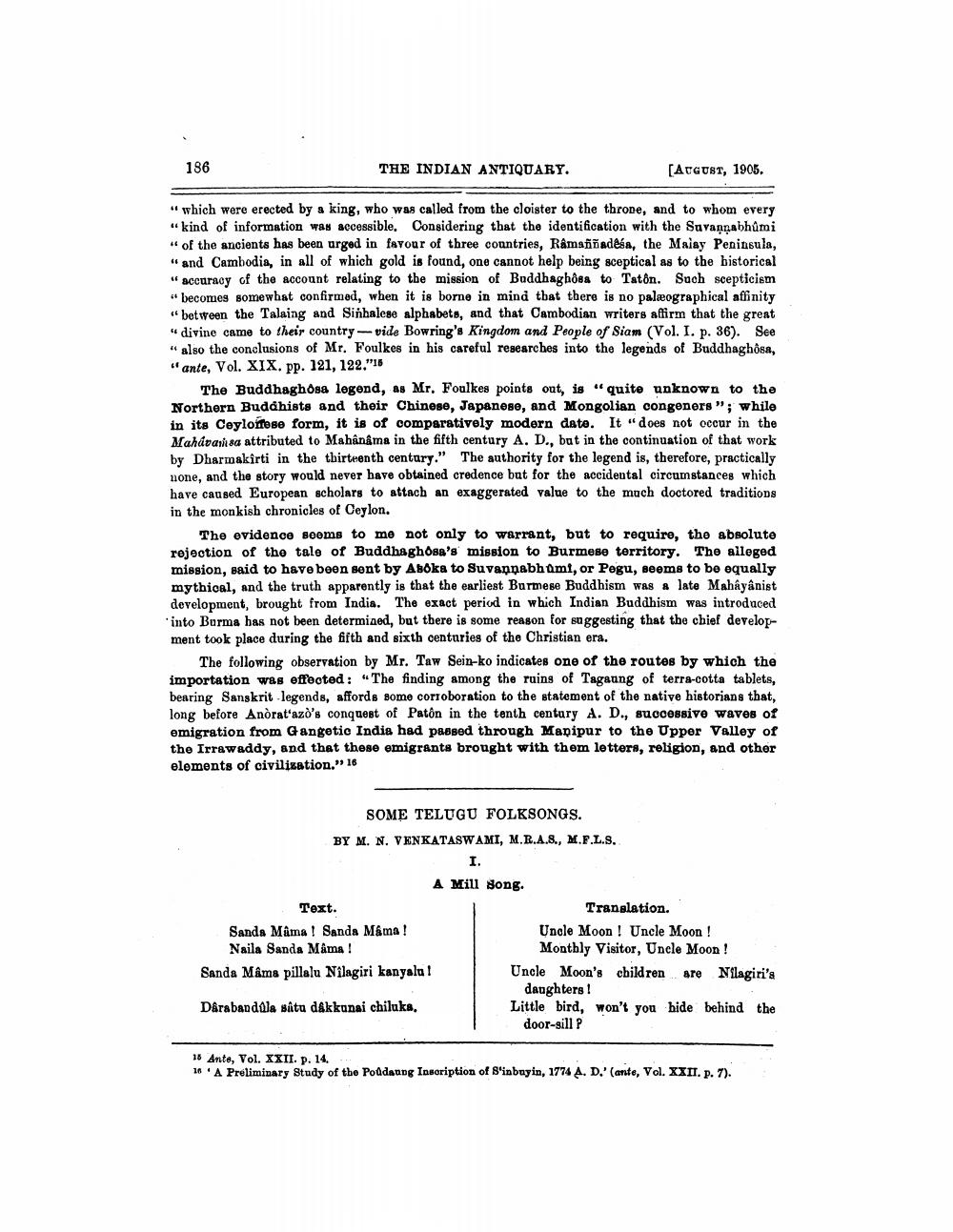________________
186
THE INDIAN ANTIQUARY.
[Argust, 1905.
" which were erected by a king, who was called from the cloister to the throne, and to whom every "kind of information was accessible. Considering that the identification with the Savannabhumi * of the ancients has been urged in favour of three countries, Râmaññadeśa, the Malay Peninsula, "and Cambodia, in all of which gold is found, one cannot help being sceptical as to the bistorical " accuracy of the account relating to the mission of Buddhaghỏsa to Taton. Such scepticism ** becomes somewhat confirmed, when it is borne in mind that there is no palæographical affinity
between the Talaing and Sinhalese alphabets, and that Cambodian writers affirm that the great "divine came to their country --- vide Bowring's Kingdom and People of Siam (Vol. I. p. 36). See * also the conclusions of Mr. Foulkes in his careful researches into the legends of Buddhaghosa, "ante, Vol. XIX. pp. 121, 122."16
The Buddhaghöga legend, as Mr. Foulkes points out, is " quite unknown to the Northern Buddhists and their Chinese, Japanese, and Mongolian congeners"; while in its Ceylortese form, it is of comparatively modern date. It "does not occur in the Mahavarisa attributed to Mahanama in the fifth century A. D., but in the continuation of that work by Dharmakirti in the thirteenth century." The authority for the legend is, therefore, practically none, and the story would never have obtained credence but for the accidental circumstances which have caused European scholars to attach an exaggerated value to the much doctored traditions in the monkish chronicles of Ceylon.
The evidence seems to me not only to warrant, but to require, the absolute rejection of the tale of Buddhaghosa's mission to Burmese territory. The alleged mission, said to have been sent by Abbka to Suvannabhumi, or Pegu, seems to be equally mythical, and the truth apparently is that the earliest Burmese Buddhism was # late Mahayanist development, brought from India. The exact period in which Indian Buddhism was introduced into Burma has not been determined, but there is some reason for suggesting that the chief development took place during the fifth and sixth centuries of the Christian era.
The following observation by Mr. Taw Sein-ko indicates one of the routes by which the importation was effected: "The finding among the ruins of Tagaung of terra-cotta tablets, bearing Sanskrit legends, affords some corroboration to the statement of the native historians that, long before Anòratóazo's conquest of Patôn in the tenth century A. D., Successive waves of emigration from Gangetic India had passed through Manipur to the Upper Valley of the Irrawaddy, and that these emigrants brought with them letters, religion, and other elements of civilization." 16
SOME TELUGU FOLKSONGS. BY M. N. VENKATASWAMI, M.R.A.8., M.F.L.S.
A Mill song. Text.
Translation. Sanda Mama! Sanda Mama!
Uncle Moon ! Uncle Moon ! Naila Sanda Mama!
Monthly Visitor, Uncle Moon! Sanda Mama pillalu Nilagiri kanyala!
Uncle Moon's children are Nilagiri'a
daughters! Daraband dla situ dekkunai chiluka,
Little bird, won't you hide behind the
door-sill?
18 Ante, Vol. XXII. p. 14. 16 A Preliminary study of the Poddaung Inscription of S'inbayin, 1774 A. D.' (ante. Vol. XXII. p. 7).




